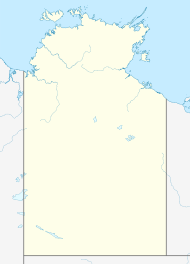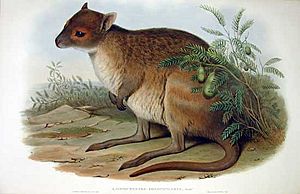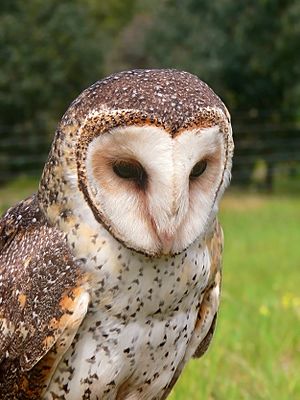Pungalina-Seven Emu Sanctuary facts for kids
Quick facts for kids Pungalina-Seven EmuNorthern Territory |
|
|---|---|
|
IUCN Category II (National Park)
|
|
| Nearest town or city | Borroloola |
| Established | 2009 |
| Area | 3,072.12 km2 (1,186.2 sq mi) |
| Managing authorities | Australian Wildlife Conservancy |
| Website | Pungalina-Seven Emu |
| See also | Protected areas of the Northern Territory |
The Pungalina-Seven Emu Sanctuary is a huge protected area in the Northern Territory of Australia. It covers about 3,060 square kilometers, which is a very large space! This special place is looked after by the Australian Wildlife Conservancy (AWC). They bought part of the land, Pungalina Station, in 2009.
The sanctuary is located next to the Gulf of Carpentaria. This is a big bay on Australia's northern coast. It's also close to the border with Queensland. The nearest town is Borroloola, which is about 150 kilometers away to the west.
Contents
History of Pungalina-Seven Emu
This sanctuary is made up of two different properties. These were once used for farming animals. One part is Pungalina, which used to be a cattle station. The other part is Seven Emu.
Seven Emu is owned by Frank Shadforth, a man from the Garrwa people. Since 2009, he has rented out a large part of his land, about 110,000 hectares, to the AWC. This land is now used to protect wildlife. Seven Emu also has 55 kilometers of coastline. This connects Pungalina to the sea.
This agreement is very important. It's a partnership between a group that protects nature and an Indigenous landowner.
Why is it called Seven Emu?
The name Seven Emu comes from Seven Emu Creek. This creek flows through the property. An explorer named Ludwig Leichhardt gave the creek its name. He was on his way to Port Essington in 1844–45. He saw and shot a group of emus nearby.
Landscape and Ecosystems
The area around the Gulf of Carpentaria has a special landscape. It has gently rolling plains along the coast. There are also some rocky areas with sandstone hills. The soil is mostly sandy.
The weather here is tropical. It gets between 800 and 1200 mm of rain each year. Most of this rain falls from December to March. Cyclones are also common. Many big rivers flow through this area.
Habitats in the Sanctuary
The Pungalina-Seven Emu Sanctuary has many different types of habitats.
- In the south, there are eucalypt woodlands. These grow on high, flat areas called plateaus. There are also small areas of dry rainforest in deep valleys.
- Further north, you find floodplain woodlands and freshwater wetlands.
- Closer to the coast, there are coastal monsoon rainforests.
- You can also find littoral saline grasslands, mangroves, and intertidal mudflats.
There is a clear change in the land between the plateau and the floodplain. This change is marked by a steep slope. The Calvert River flows through the sanctuary. It goes through steep valleys and then across the lowlands. Finally, it empties into the Gulf of Carpentaria.
Amazing Animals of Pungalina
In 2009, scientists did a survey of the animals here. They found over 231 different kinds of animals with backbones. This included 19 native mammals, 151 birds, and 61 types of reptiles and frogs. This is more than half of all the native animals expected to live in the area!
Threatened Species
Some of the animals found here are considered threatened. This means they are at risk of disappearing. These include:
- The masked owl
- The red goshawk
- The Gouldian finch
- The Carpentarian false antechinus
- The freshwater sawfish
- Mertens' water monitor
- The Gulf snapping turtle
Other Animals You Might See
Other birds and mammals living in the sanctuary include:
- The purple-crowned fairy-wren
- The Australian bustard
- The short-eared rock-wallaby
- The spectacled hare-wallaby
- The northern brown bandicoot
Marine Life
Near the beaches, you might spot marine animals like:
- Indo-Pacific humpback dolphins
- loggerhead turtles
- Green turtles
- shovelnose sharks
- Giant trevally
- And, of course, saltwater crocodiles!
Scientists are still learning about the birds in this region. The Pungalina-Seven Emu Sanctuary helps fill in gaps in their knowledge. Birds like the Pacific baza, little bronze-cuckoo, figbird, and white-breasted whistler have been seen here. This helps show where these birds live across Australia.
Seven Emu Station: A Family Legacy
Seven Emu Station is still a working cattle station today. It has been owned by the Shadforth family since 1953. That's when Willie Shadforth, a Garawa man, bought it with cash.
The Shadforths were one of the first families to settle in this area. Many Shadforth men married local Garawa and Yanyuwa women. Willie was a very skilled cattle drover and horse trader. He moved cattle and horses across many parts of Australia.
How Willie Bought the Station
Willie bought the land for £10,000. He won money on a horse race called the Caulfield Cup. Then, he bet all his winnings on another horse in the Melbourne Cup and won again! He was the first Indigenous Australian to buy such a large property.
Willie passed the station down to his son, Frank. Frank is the seventh of ten children. Today, Frank looks after guests who visit. Frank's son, Clarry, and his children manage the cattle.
Sharing Culture and History
Tourists who visit Seven Emu Station can go on guided tours. These tours share some of the Garawa traditions and culture. Visitors also learn about the native animals and stories of European explorers. Willie made sure to keep his traditional culture alive. He taught his knowledge to Frank, including ceremonies and laws.
Helping Young People
Frank started a program in the 2010s to help Aboriginal boys and girls. These young people may have had problems in their lives. The program gives them a second chance. They learn useful skills like catching bulls, building fences, and mustering cattle.
In 2020, the Northern Territory Government started helping to fund this program. They promised A$4.5 million over five years. This money will help run youth camps. There will be short, intense camps and longer ones.
Dale Wakefield, a government minister, said the camps teach young people about being responsible. They also help them find a way out of trouble. The camps connect them with practical learning and job training. New homes will be built for young people who stay in the long-term camps. These camps are for youths who are struggling to get out of the youth justice system in the Northern Territory.





